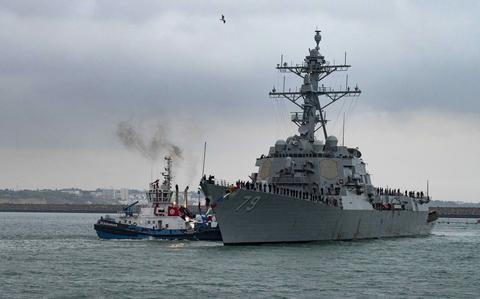The destroyer USS Oscar Austin arrives at Naval Station Rota, Spain, completing its homeport shift from Naval Station Norfolk, Va., Oct. 15, 2024. Oscar Austin is the first of two additional destroyers planned for the Navy base on Spain’s Atlantic coast. (Drace Wilson/U.S. Navy)
NAPLES, Italy — The first of two additional destroyers planned for a Navy base in Spain arrived this week, heralding a long-anticipated expansion of NATO firepower in Europe.
USS Oscar Austin arrived at Naval Station Rota on Tuesday, joining four other destroyers already homeported there, U.S. Naval Forces Europe-Africa/U.S. 6th Fleet said in a statement.
The ship’s homeport switch follows a May 2023 pact with Spain to increase the U.S. destroyer presence in the country from four to six.
Oscar Austin joins USS Roosevelt, USS Arleigh Burke, USS Bulkeley and USS Paul Ignatius as part of Destroyer Squadron 60. The sixth destroyer, which hasn’t been publicly identified, is anticipated to join the squadron in 2026.
Petty Officer 2nd Class David Gaddis, assigned to the destroyer USS Oscar Austin, greets his family during the ship’s homeport shift to Naval Station Rota, Spain, from Naval Station Norfolk, Va., Oct. 15, 2024. (Drace Wilson/U.S. Navy)
The ship’s arrival provides allies “an added layer of security and assurance,” Vice Adm. Jeffrey Anderson, commander of 6th Fleet and Naval Striking and Support Forces NATO, said in the statement.
The increased naval presence comes as U.S. military commanders in Europe warn that Russian spies and saboteurs are escalating the risk of wider conflict on the Continent.
“The miscalculation piece is as high as it’s ever been,” U.S. Army Europe and Africa’s Gen. Darryl Williams said Tuesday in Washington, describing the Russian operatives as “nontraditional” and lacking the training of their predecessors.
The war in Ukraine, Russian threats in the Baltic Sea and the effects of the Israel-Hamas war in the eastern Mediterranean have brought greater focus on the European theater than at any time since the Cold War.
More U.S. ships, aircraft and tens of thousands of additional personnel have arrived in the region over the last two years.
For example, the Navy has kept an aircraft carrier strike group or amphibious assault group presence in the NAVEUR-AF/6th Fleet area of responsibility on a near-continuous basis since Russia’s full-scale invasion of Ukraine.
Cmdr. Scott Burrill, right, the commanding officer of the destroyer USS Oscar Austin, raises a Spanish flag with Spanish navy Capt. Ernesto Guesos, commander of the 41st Frigate Squadron, after the completion of the ship’s homeport shift to Naval Station Rota, Spain, from Norfolk, Va., Oct. 15, 2024. (Drace Wilson/U.S. Navy)
The Harry S. Truman Carrier Strike Group, including the destroyers USS Stout and USS Jason Dunham and the cruiser USS Gettysburg, recently arrived in the North Sea.
The destroyers work in conjunction with land-based Aegis ballistic missile defense sites to protect Europe.
The U.S. began keeping destroyers in Spain in 2014, beginning with USS Ross and USS Cook.
The vessels are armed with vertical launch anti-submarine rockets, Tomahawk missiles and MK-46 torpedoes. They are designed for anti-air, anti-submarine and anti-surface warfare, and the most recent versions can simultaneously defend against aircraft and missiles, according to the Navy.
Stars and Stripes reporter John Vandiver contributed to this report.
Source link : http://www.bing.com/news/apiclick.aspx?ref=FexRss&aid=&tid=670f8c9e607146c8a8b5a99620bc53b0&url=https%3A%2F%2Fwww.stripes.com%2Fbranches%2Fnavy%2F2024-10-16%2Fdestroyer-spain-oscar-austin-rota-15523438.html&c=11963531771279221234&mkt=de-de
Author :
Publish date : 2024-10-16 01:46:00
Copyright for syndicated content belongs to the linked Source.
